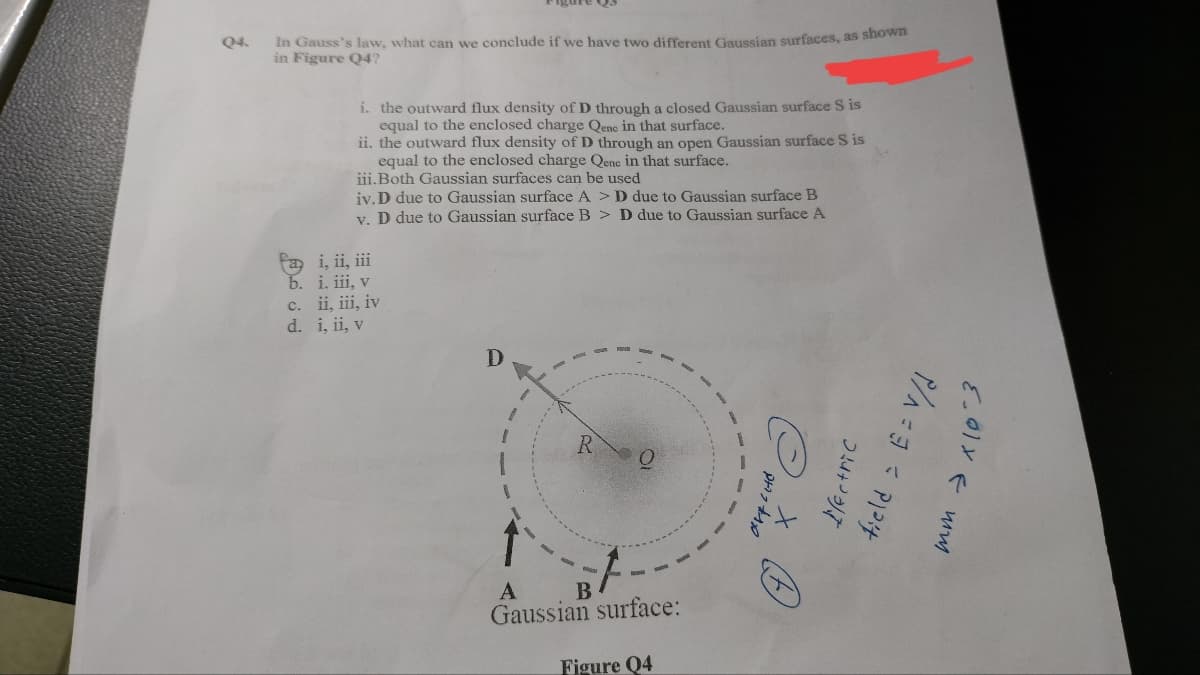Q4. In Gauss's law, what can we conclude if we have two different Gaussian surfaces, as shown in Figure Q4? i. the outward flux density of D through a closed Gaussian surface S is equal to the enclosed charge Qene in that surface. ii. the outward flux density of D through an open Gaussian surface S is equal to the enclosed charge Qene in that surface. iii.Both Gaussian surfaces can be used iv. D due to Gaussian surface A > D due to Gaussian surface B v. D due to Gaussian surface B > D due to Gaussian surface A fa i, ii, iii b. i. iii, v c. ii, iii, iv d. i, ii, v D R O Gaussian surface: Figure Q4 Electric field > E= V/d E-01 &
Q4. In Gauss's law, what can we conclude if we have two different Gaussian surfaces, as shown in Figure Q4? i. the outward flux density of D through a closed Gaussian surface S is equal to the enclosed charge Qene in that surface. ii. the outward flux density of D through an open Gaussian surface S is equal to the enclosed charge Qene in that surface. iii.Both Gaussian surfaces can be used iv. D due to Gaussian surface A > D due to Gaussian surface B v. D due to Gaussian surface B > D due to Gaussian surface A fa i, ii, iii b. i. iii, v c. ii, iii, iv d. i, ii, v D R O Gaussian surface: Figure Q4 Electric field > E= V/d E-01 &
Introductory Circuit Analysis (13th Edition)
13th Edition
ISBN:9780133923605
Author:Robert L. Boylestad
Publisher:Robert L. Boylestad
Chapter1: Introduction
Section: Chapter Questions
Problem 1P: Visit your local library (at school or home) and describe the extent to which it provides literature...
Related questions
Question

Transcribed Image Text:Q4.
In Gauss's law, what can we conclude if we have two different Gaussian surfaces, as shown
in Figure Q4?
i.
the outward flux density of D through a closed Gaussian surface S is
equal to the enclosed charge Qenc in that surface.
ii. the outward flux density of D through an open Gaussian surface S is
equal to the enclosed charge Qene in that surface.
iii.Both Gaussian surfaces can be used
iv. D due to Gaussian surface A > D due to Gaussian surface B
v. D due to Gaussian surface B > D due to Gaussian surface A
Pa i, ii, iii
b.
i. iii, v
ii, iii, iv
c.
d. i, ii, v
D
R
O
Gaussian surface:
Figure Q4
Electric
field = E= V/d
2014 (
Expert Solution
This question has been solved!
Explore an expertly crafted, step-by-step solution for a thorough understanding of key concepts.
Step by step
Solved in 3 steps with 3 images

Knowledge Booster
Learn more about
Need a deep-dive on the concept behind this application? Look no further. Learn more about this topic, electrical-engineering and related others by exploring similar questions and additional content below.Recommended textbooks for you

Introductory Circuit Analysis (13th Edition)
Electrical Engineering
ISBN:
9780133923605
Author:
Robert L. Boylestad
Publisher:
PEARSON

Delmar's Standard Textbook Of Electricity
Electrical Engineering
ISBN:
9781337900348
Author:
Stephen L. Herman
Publisher:
Cengage Learning

Programmable Logic Controllers
Electrical Engineering
ISBN:
9780073373843
Author:
Frank D. Petruzella
Publisher:
McGraw-Hill Education

Introductory Circuit Analysis (13th Edition)
Electrical Engineering
ISBN:
9780133923605
Author:
Robert L. Boylestad
Publisher:
PEARSON

Delmar's Standard Textbook Of Electricity
Electrical Engineering
ISBN:
9781337900348
Author:
Stephen L. Herman
Publisher:
Cengage Learning

Programmable Logic Controllers
Electrical Engineering
ISBN:
9780073373843
Author:
Frank D. Petruzella
Publisher:
McGraw-Hill Education

Fundamentals of Electric Circuits
Electrical Engineering
ISBN:
9780078028229
Author:
Charles K Alexander, Matthew Sadiku
Publisher:
McGraw-Hill Education

Electric Circuits. (11th Edition)
Electrical Engineering
ISBN:
9780134746968
Author:
James W. Nilsson, Susan Riedel
Publisher:
PEARSON

Engineering Electromagnetics
Electrical Engineering
ISBN:
9780078028151
Author:
Hayt, William H. (william Hart), Jr, BUCK, John A.
Publisher:
Mcgraw-hill Education,